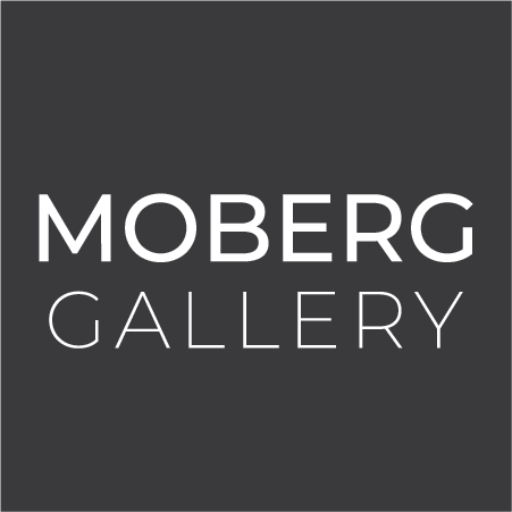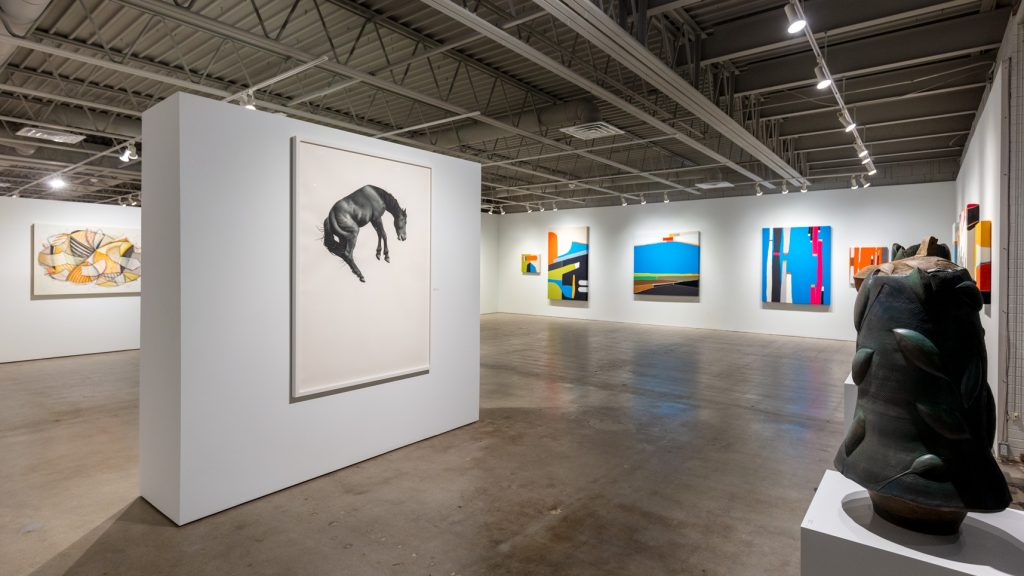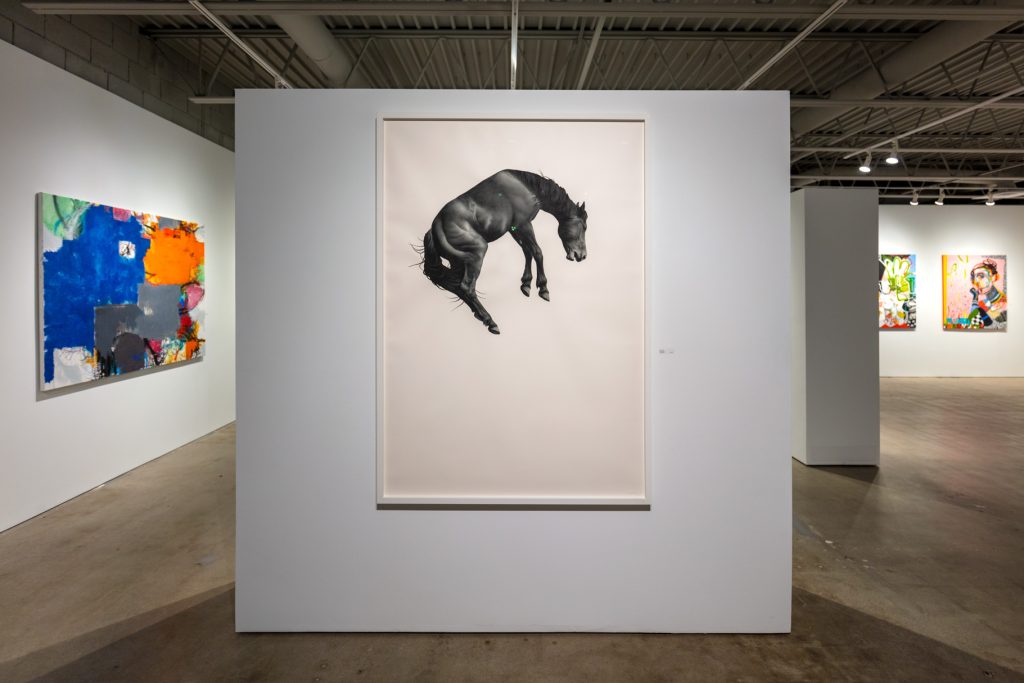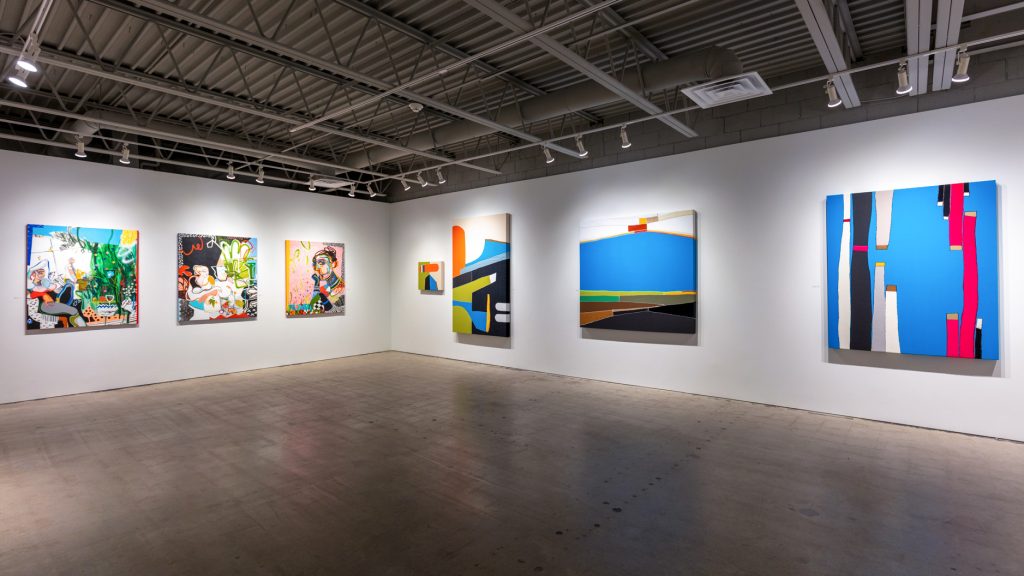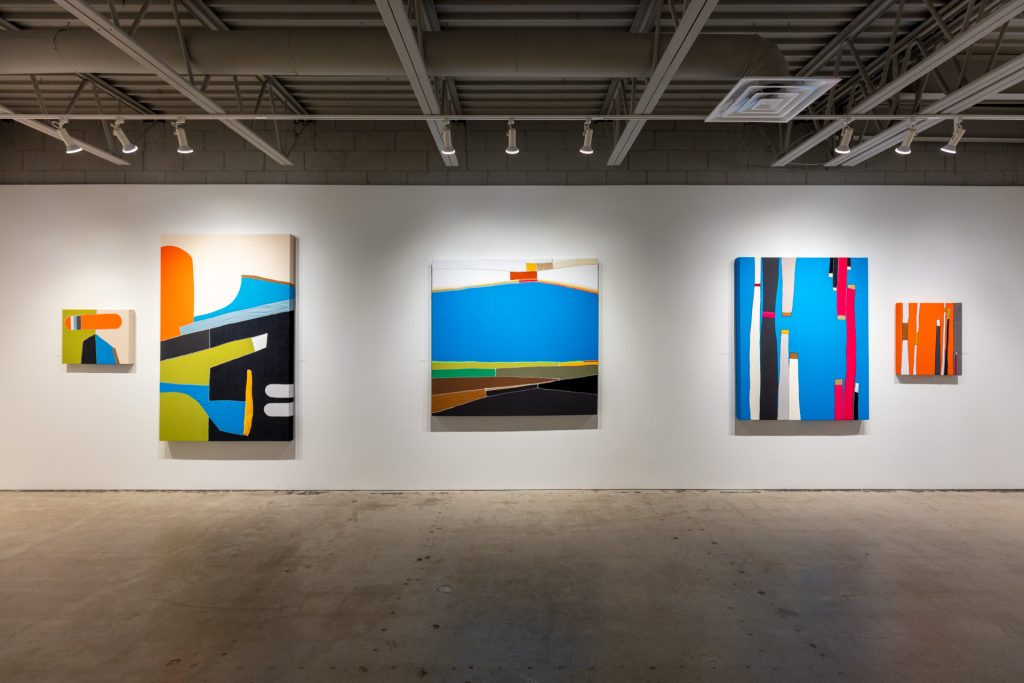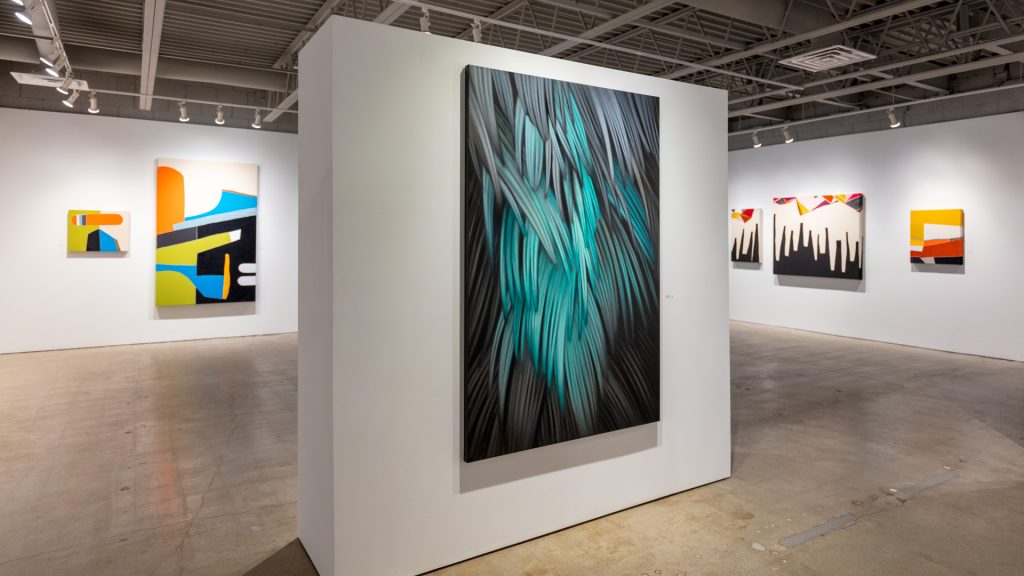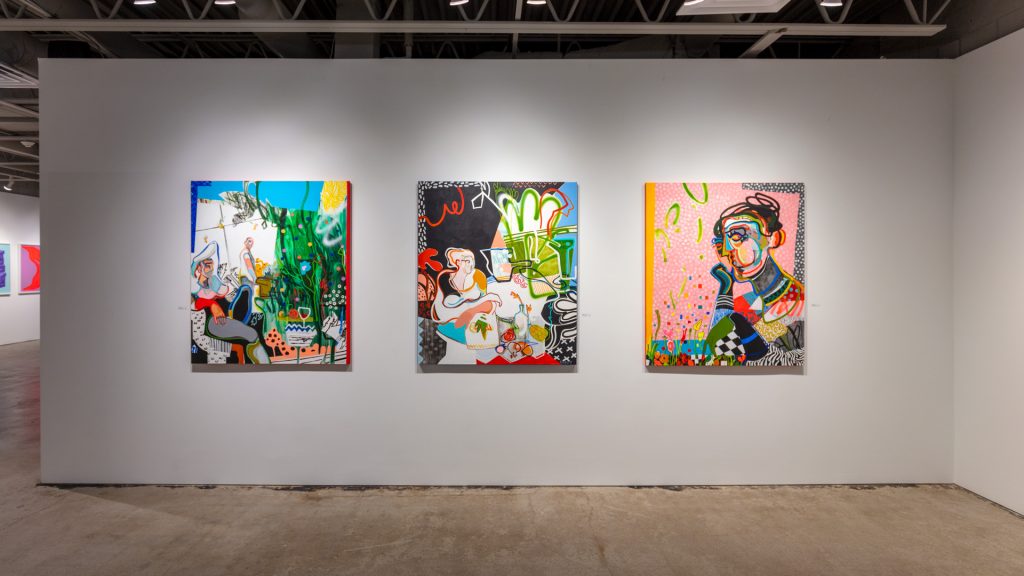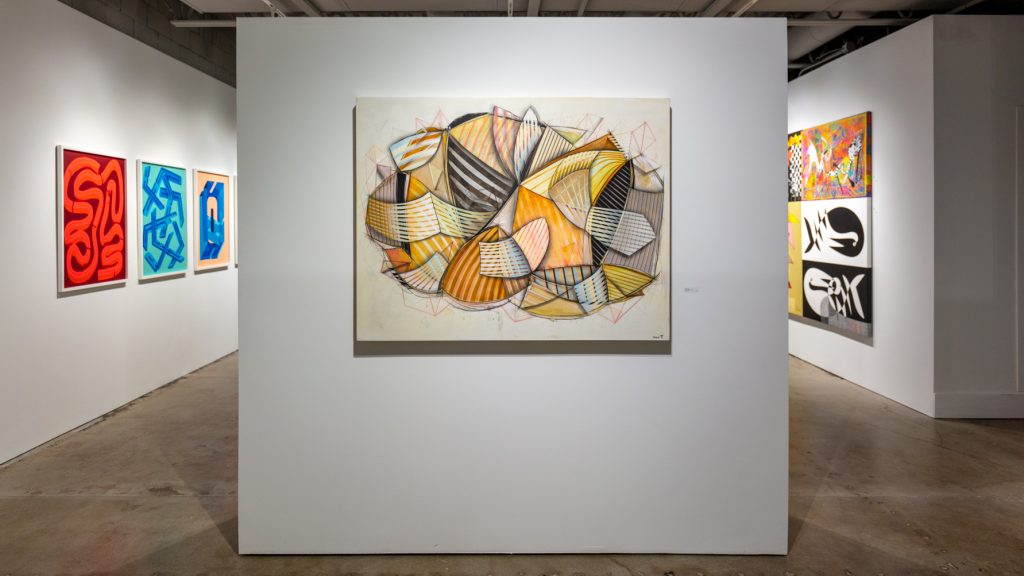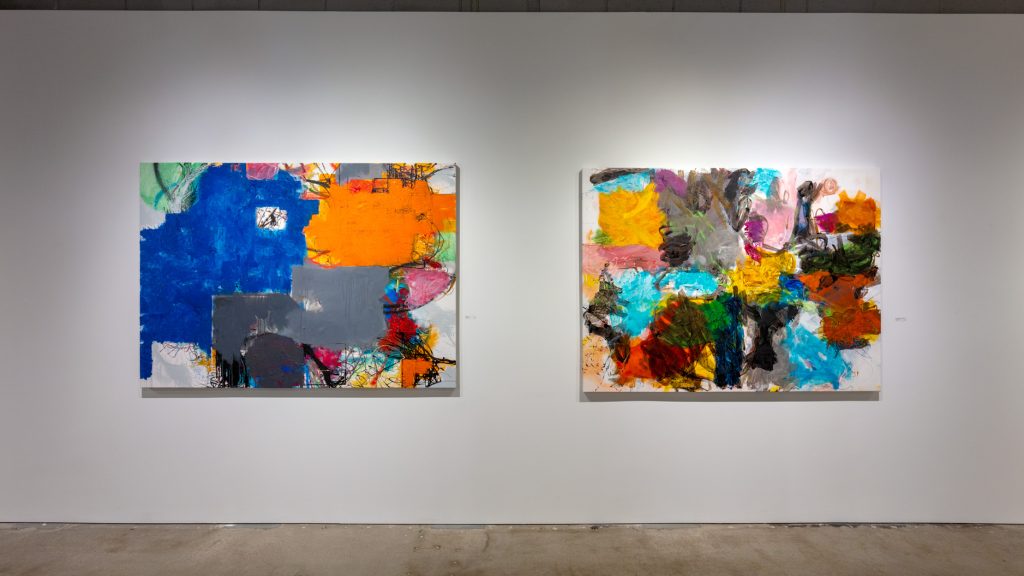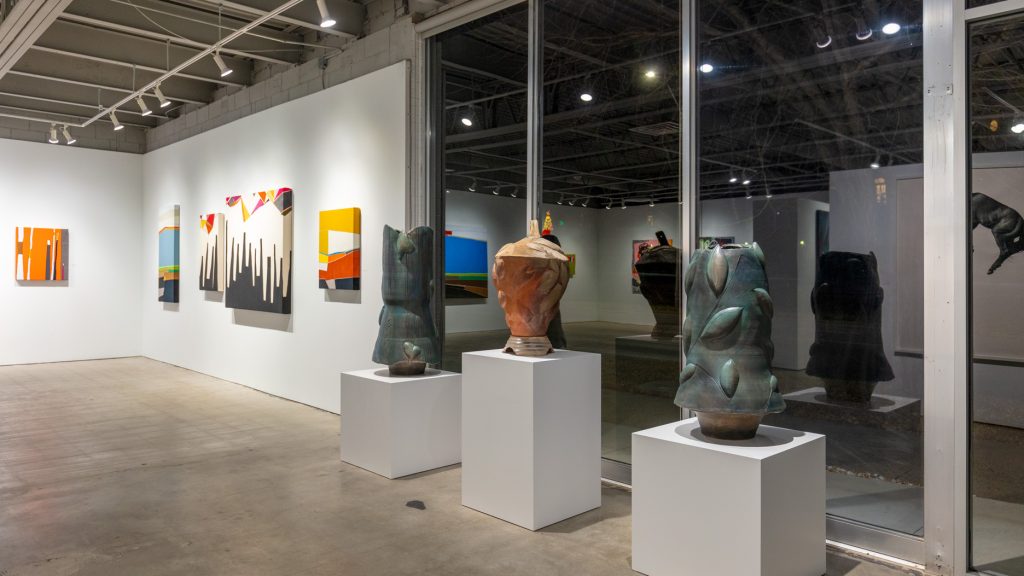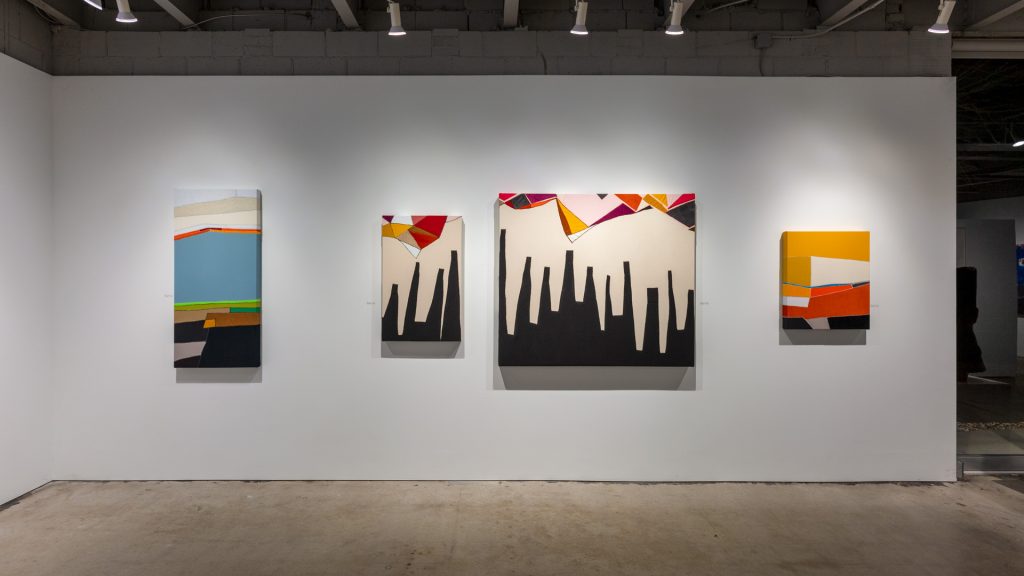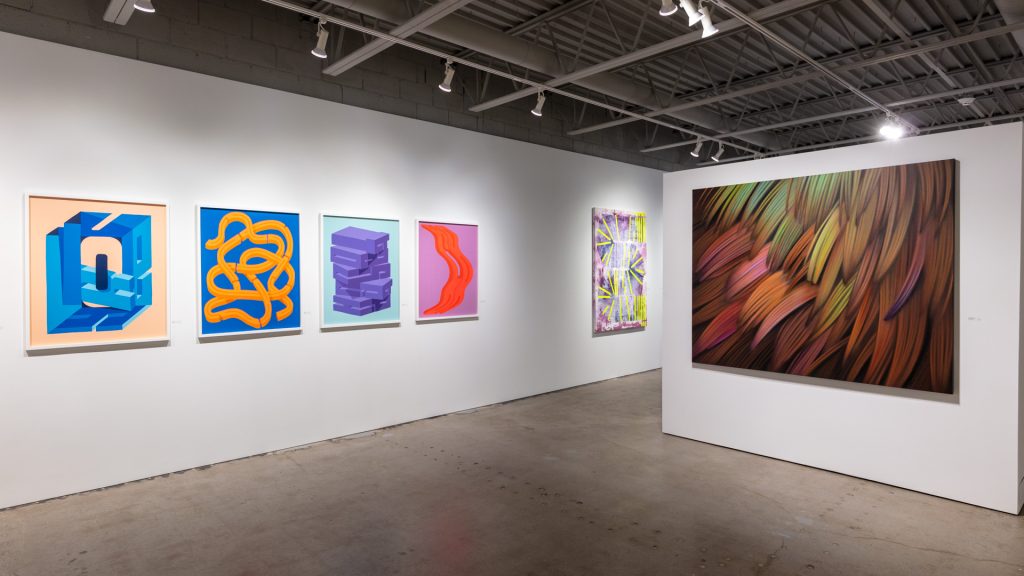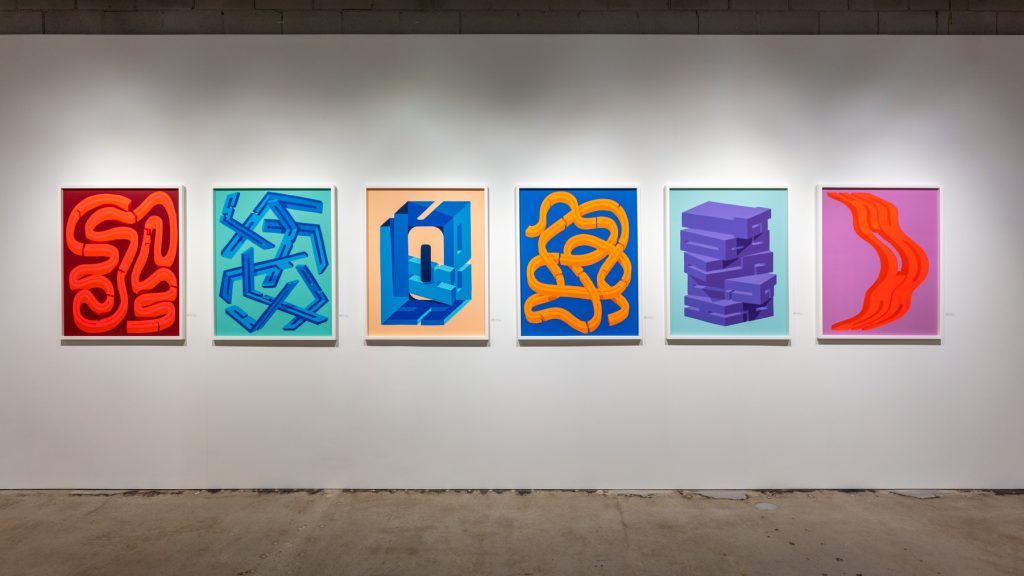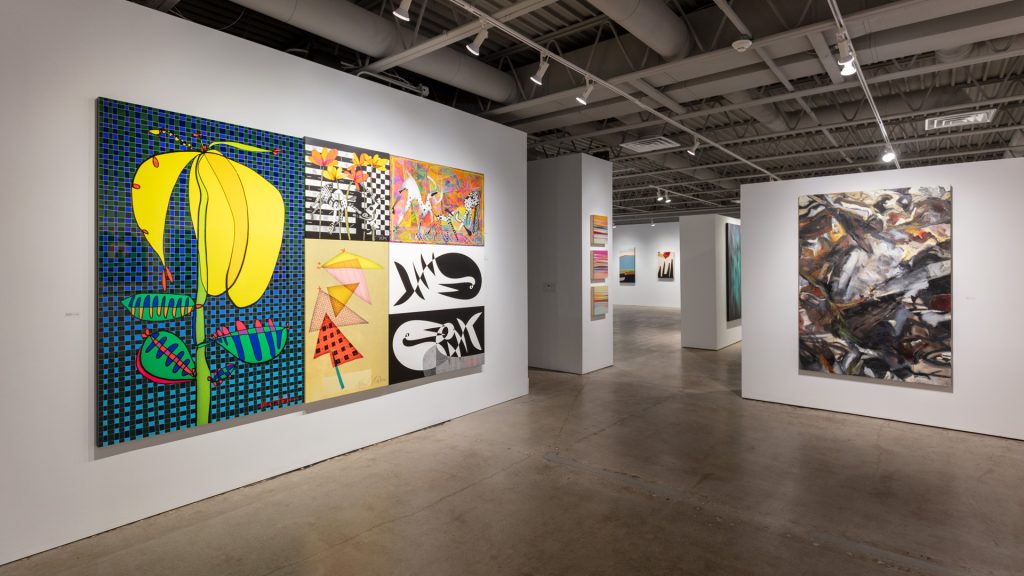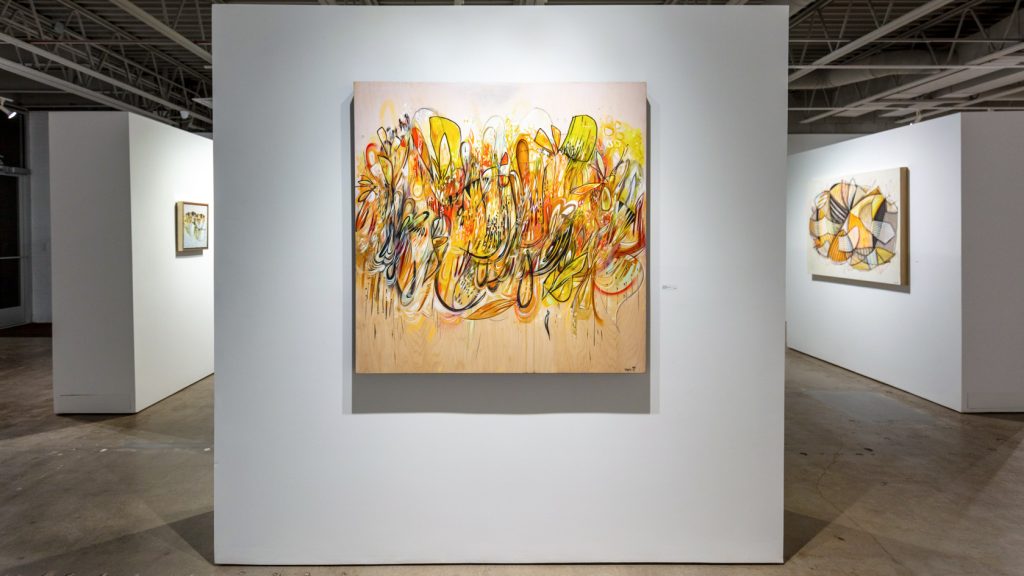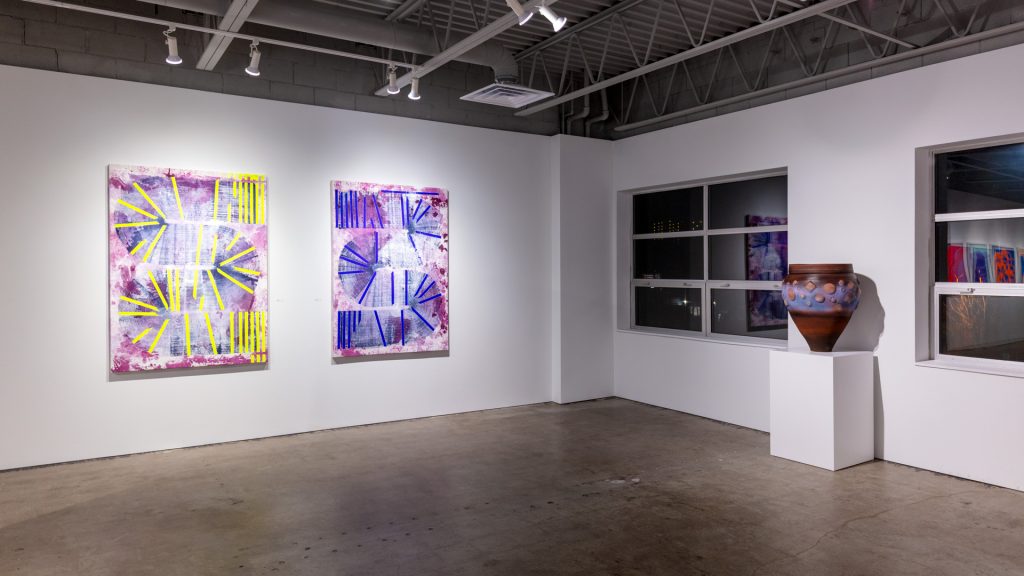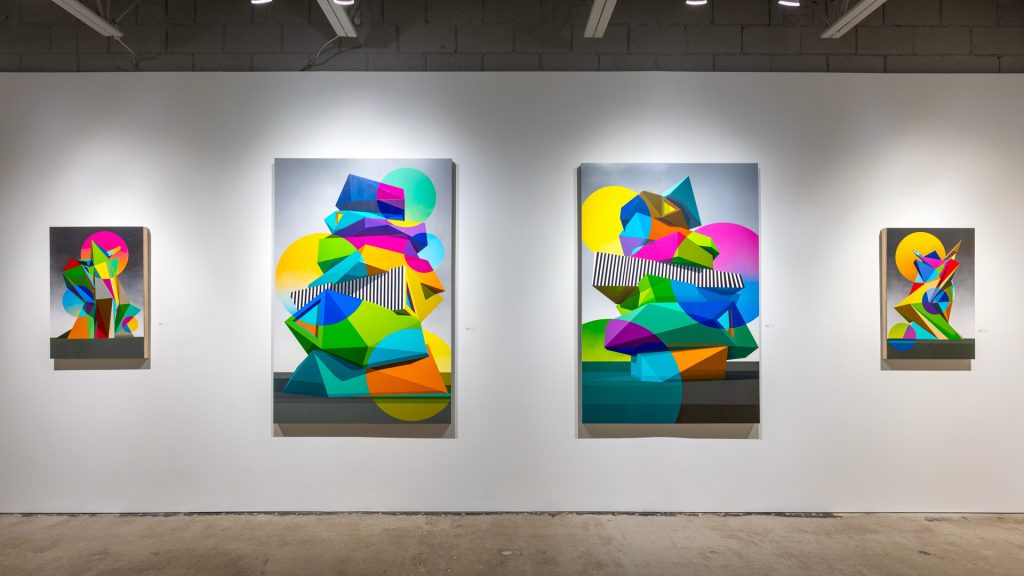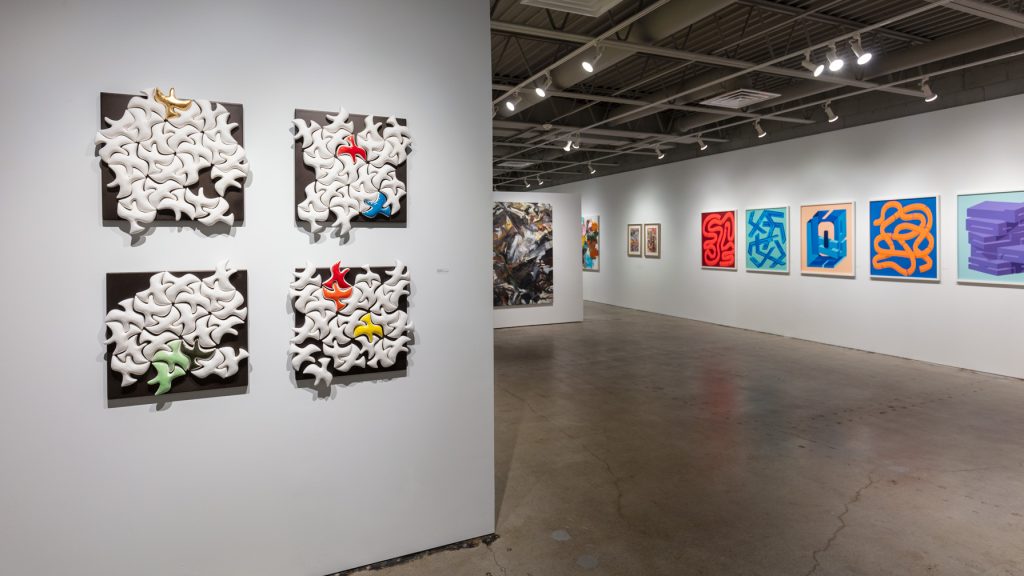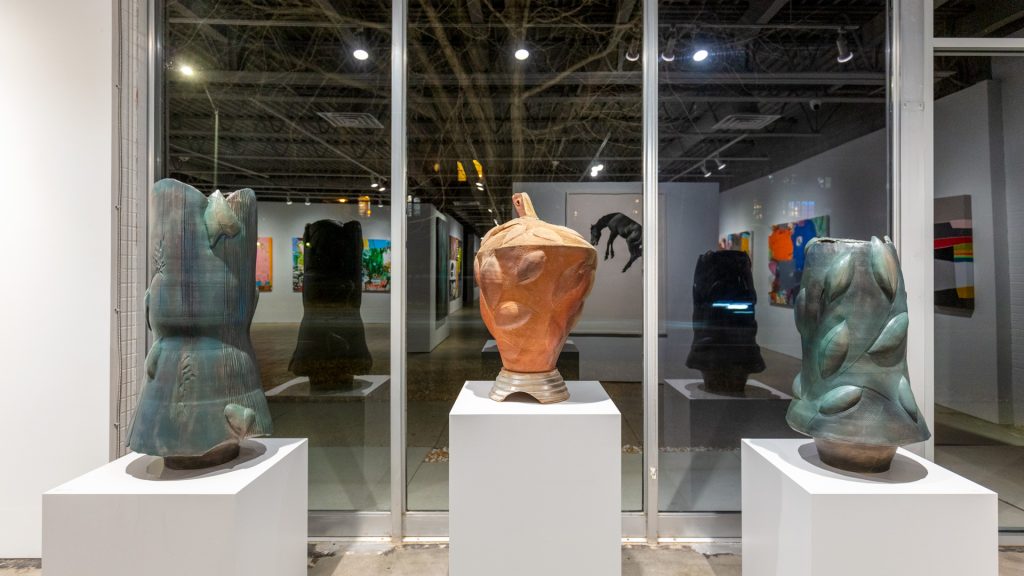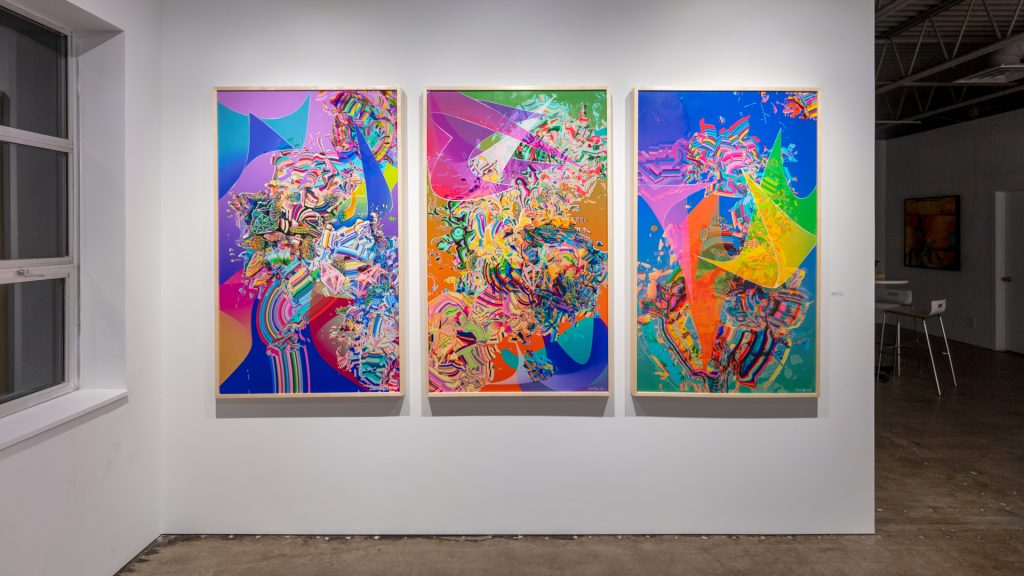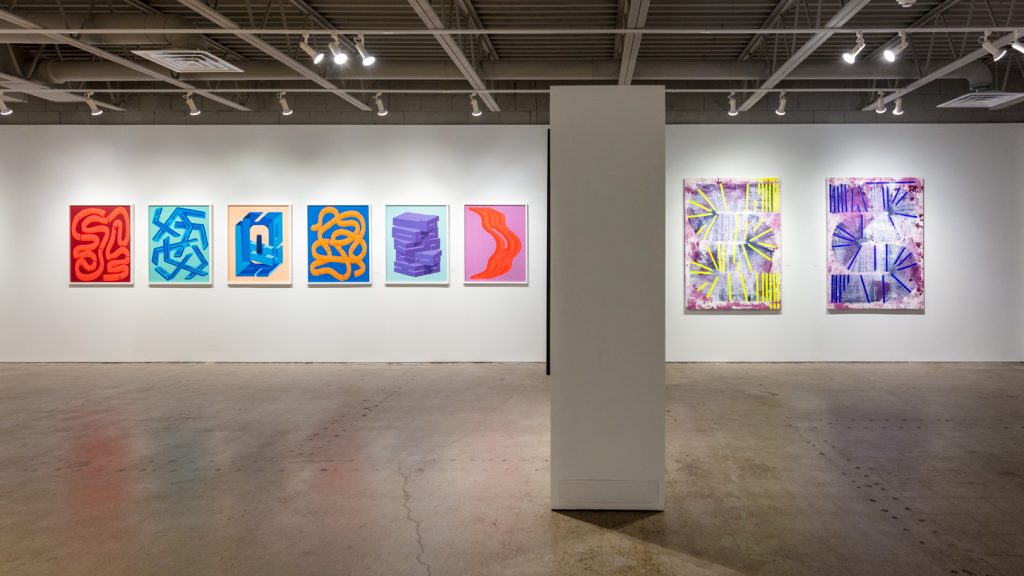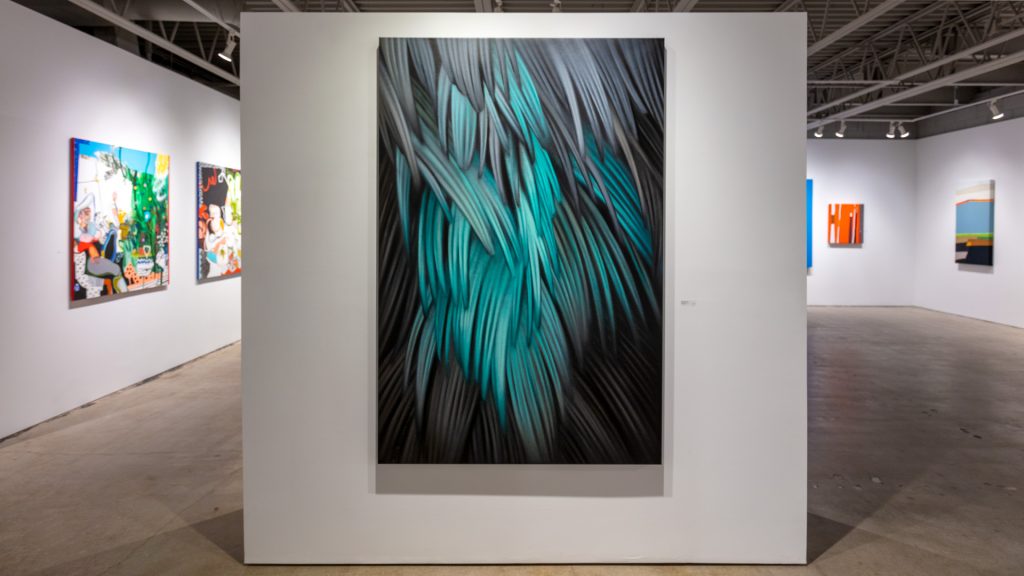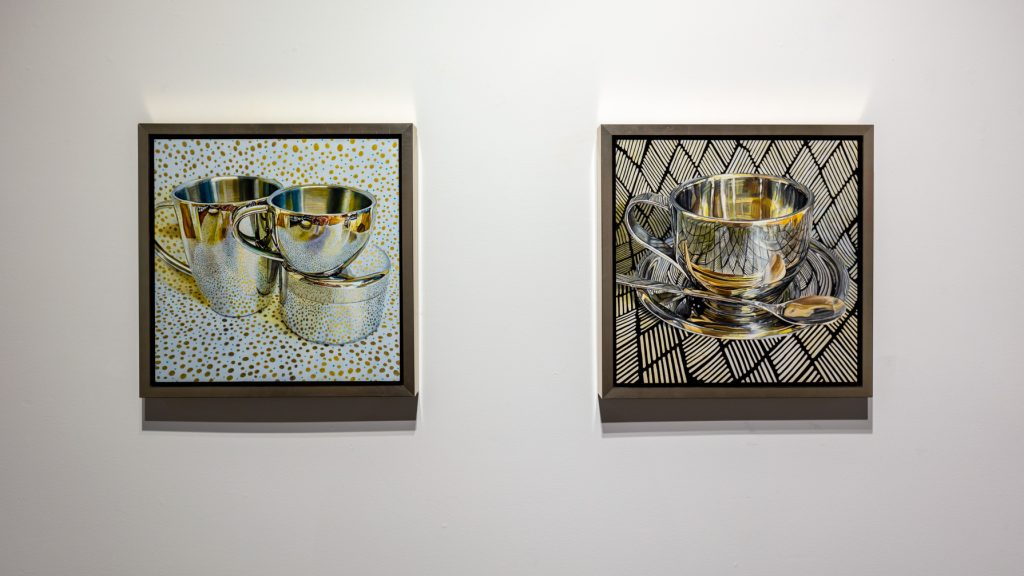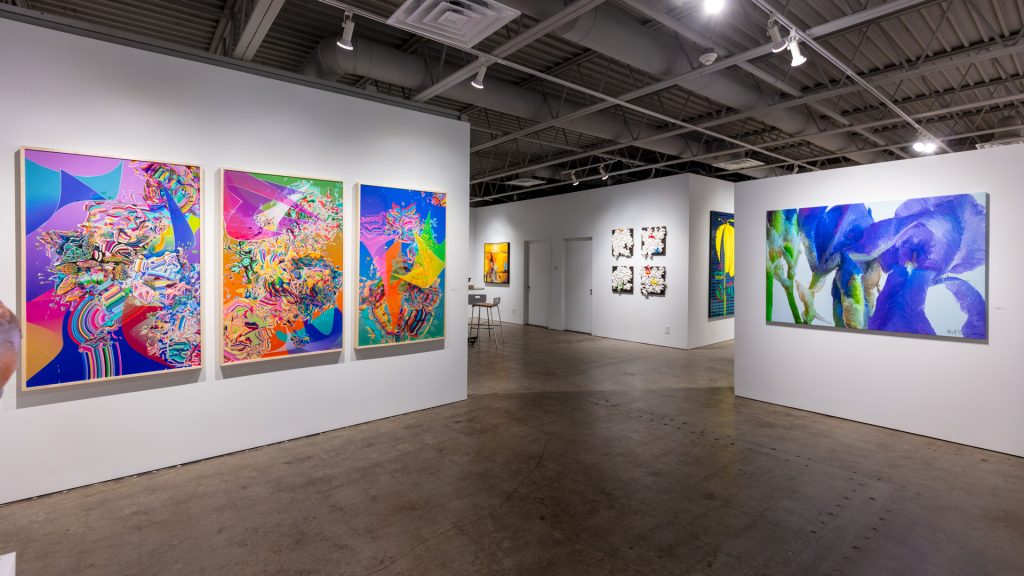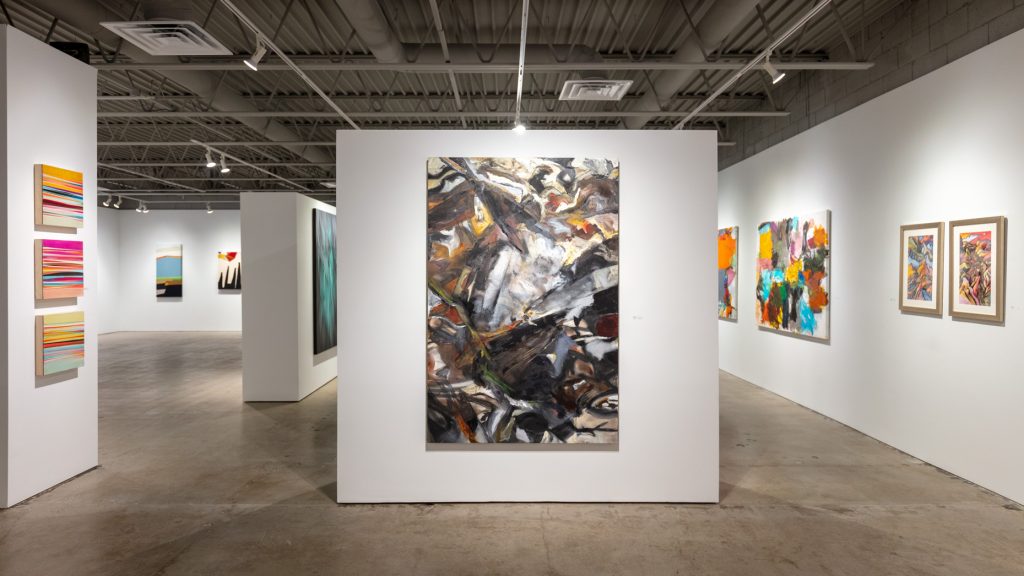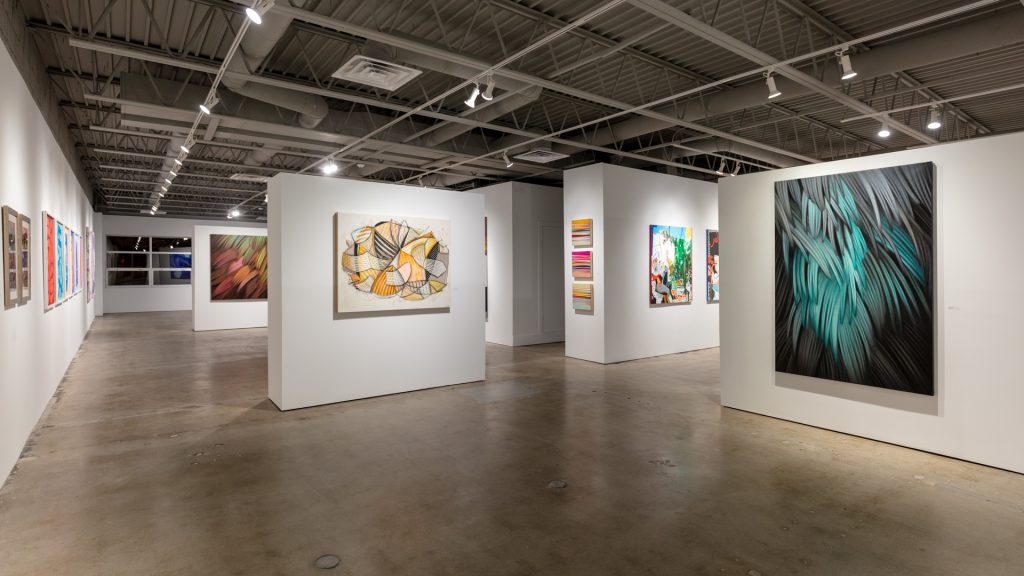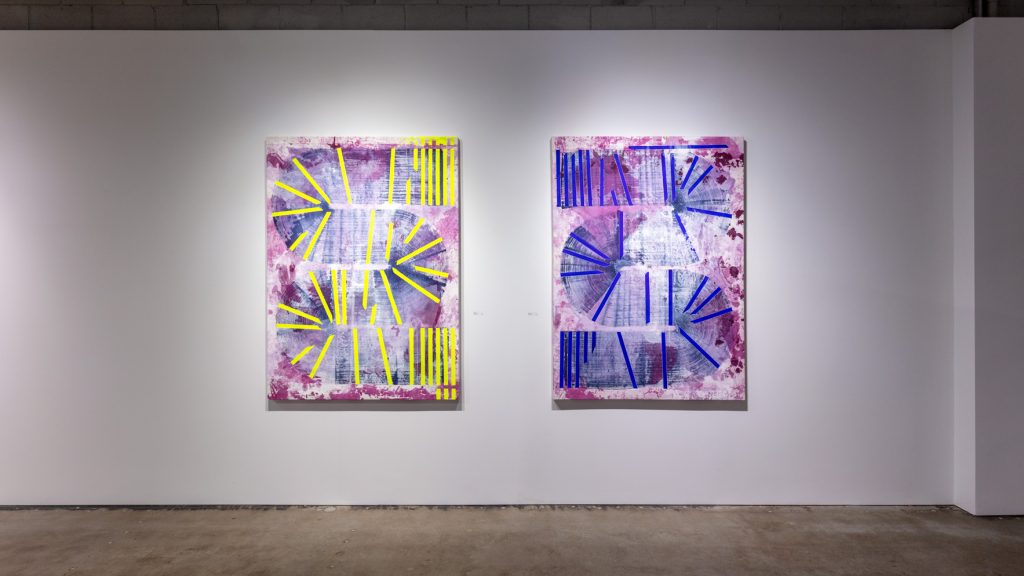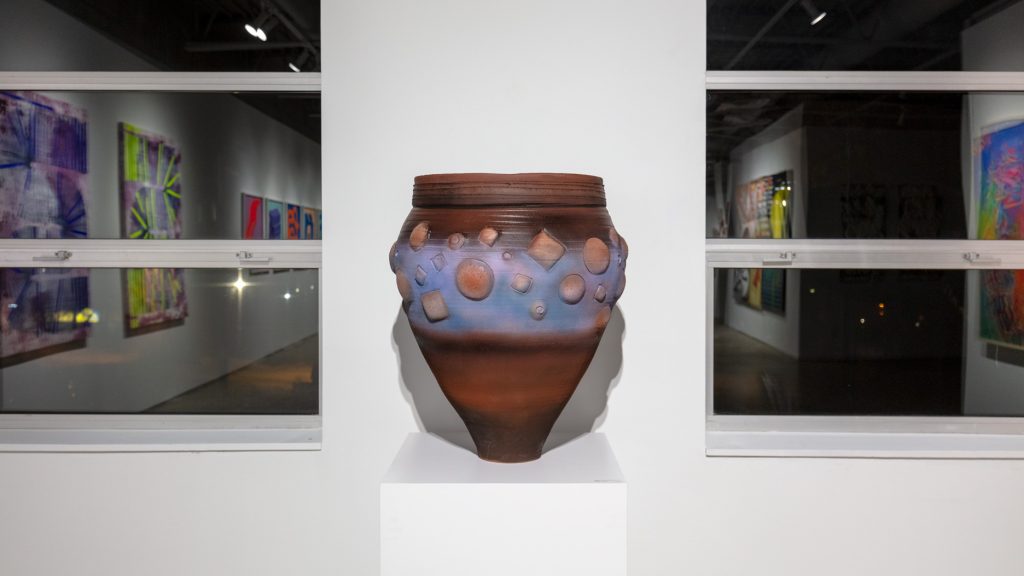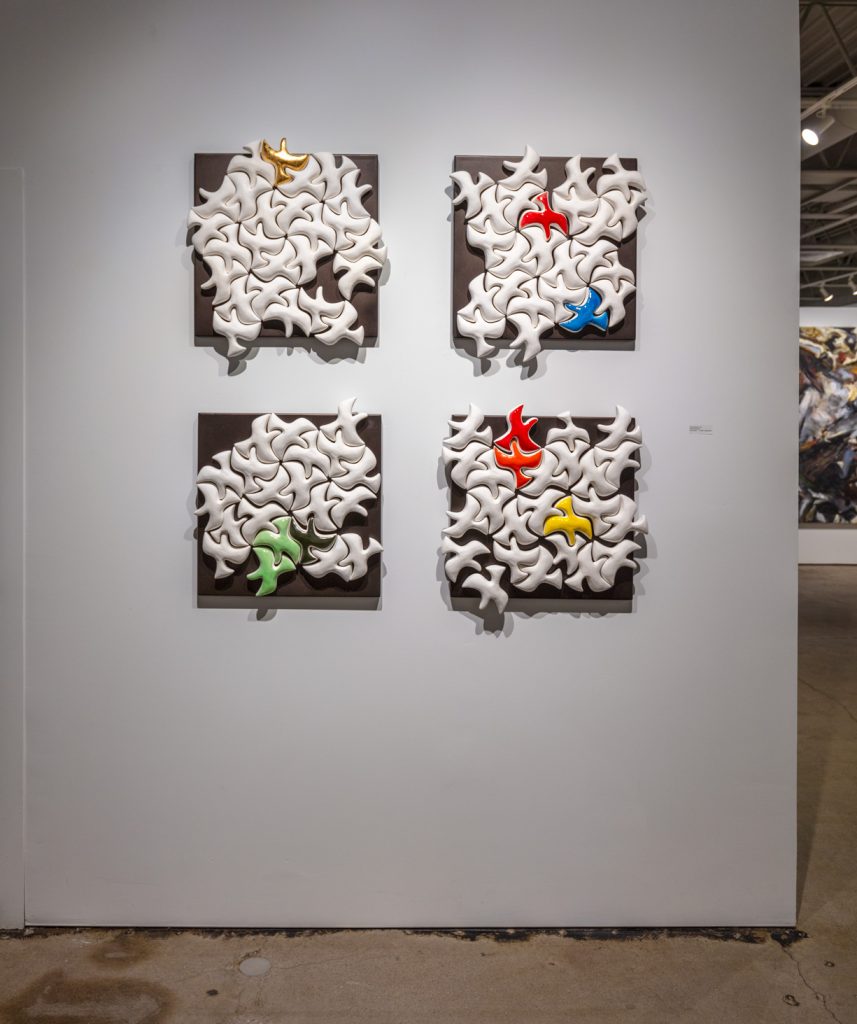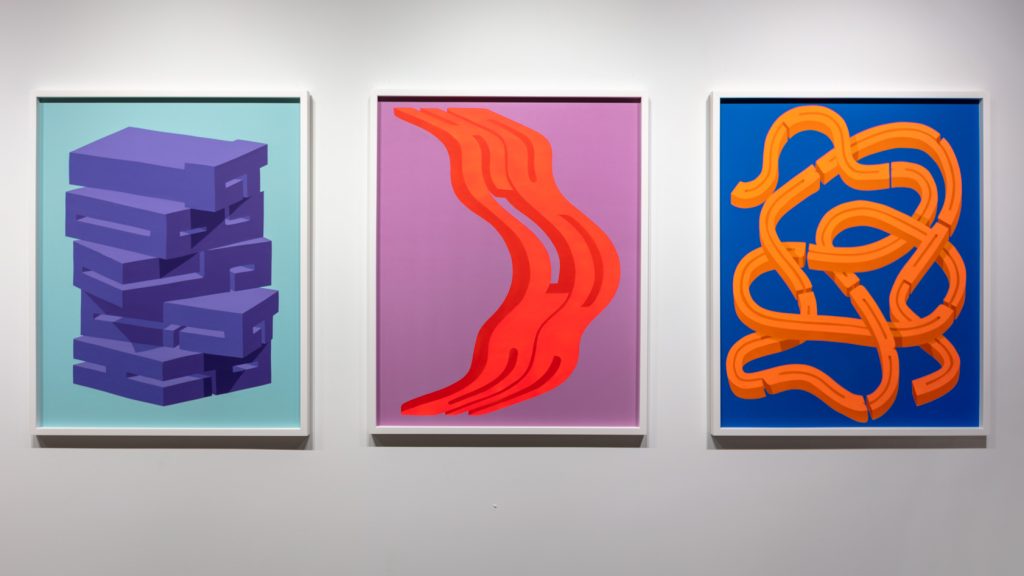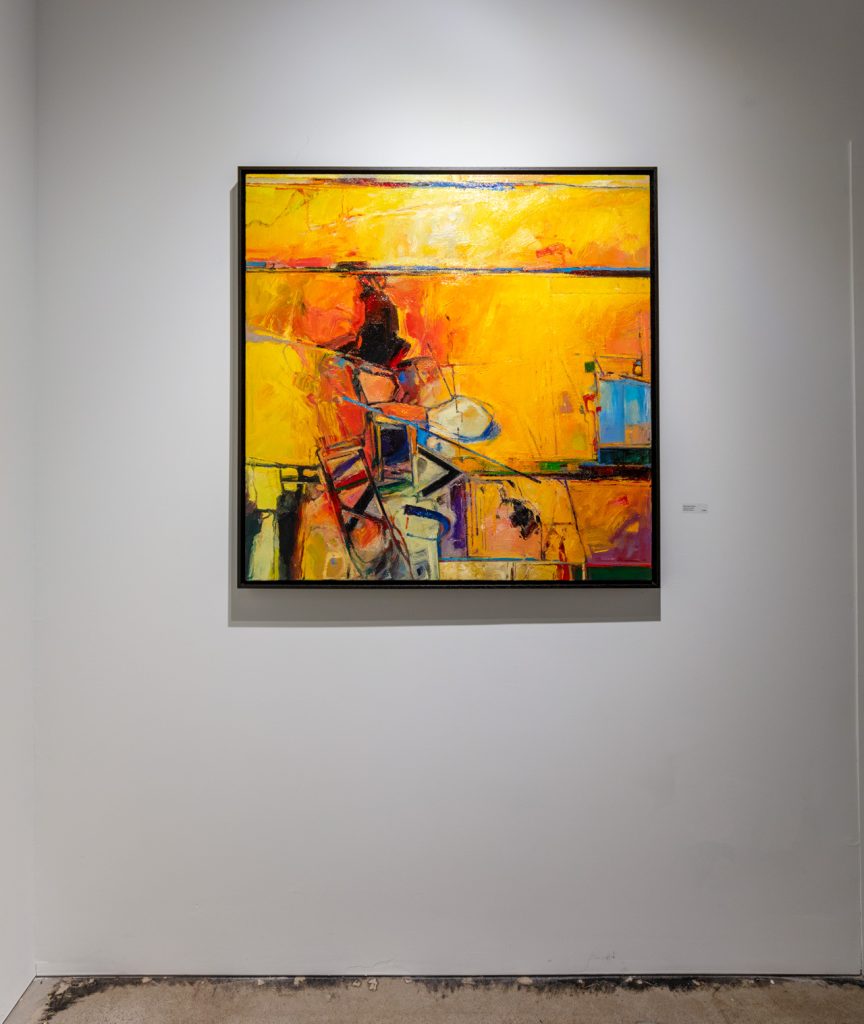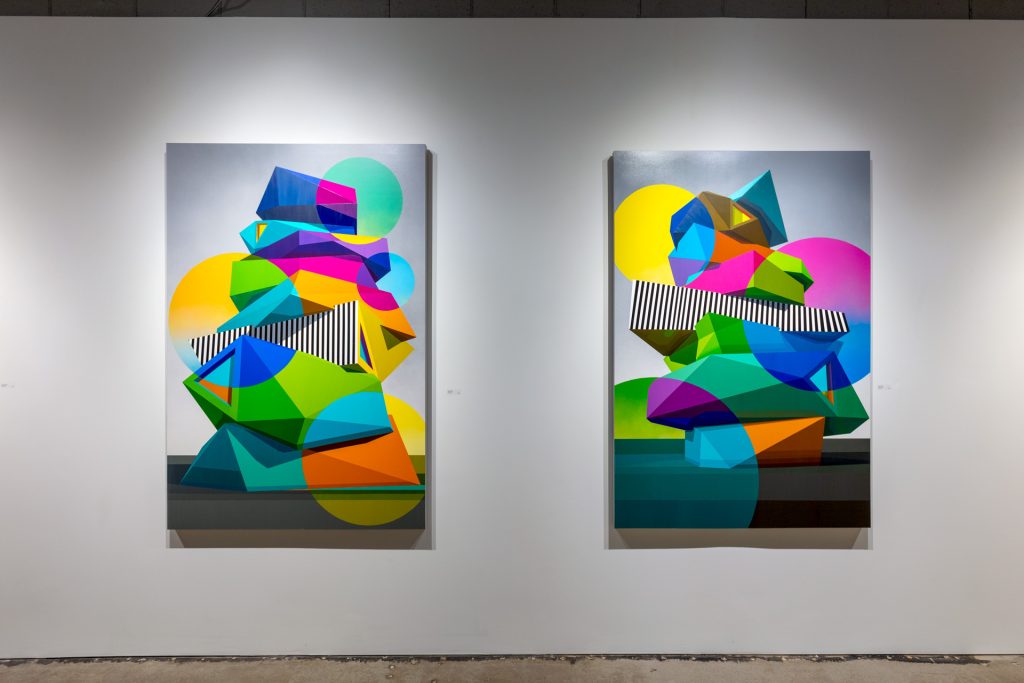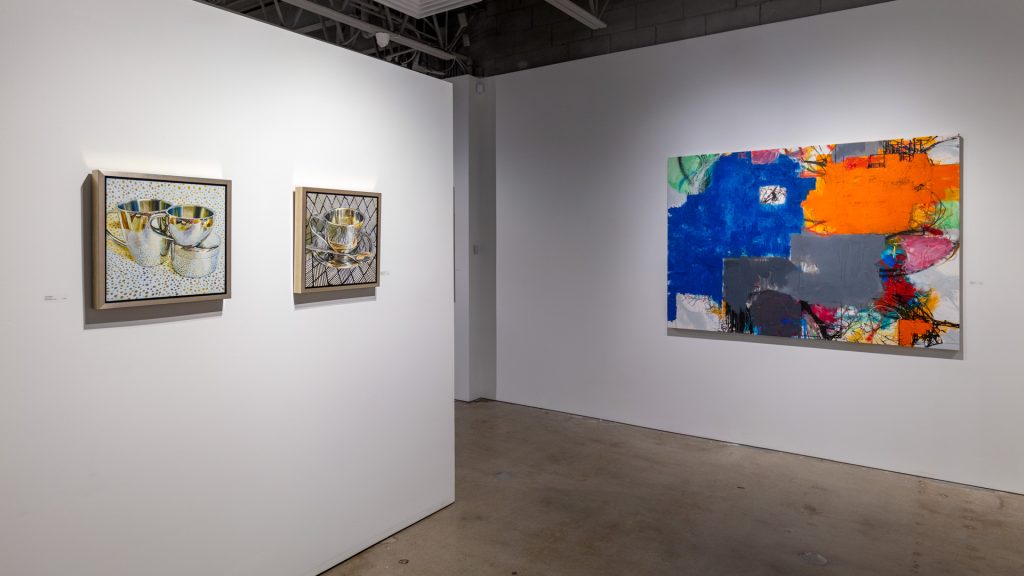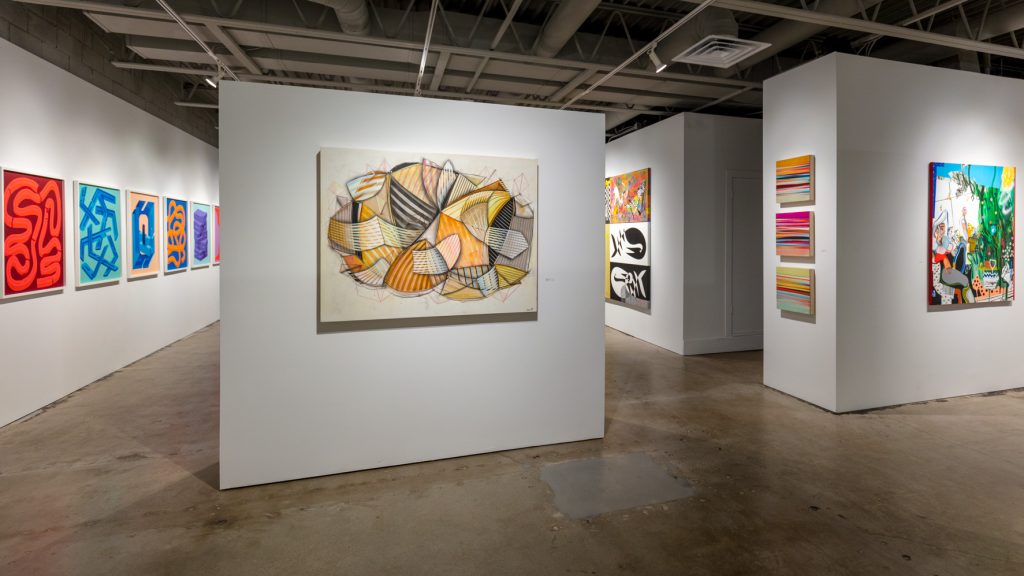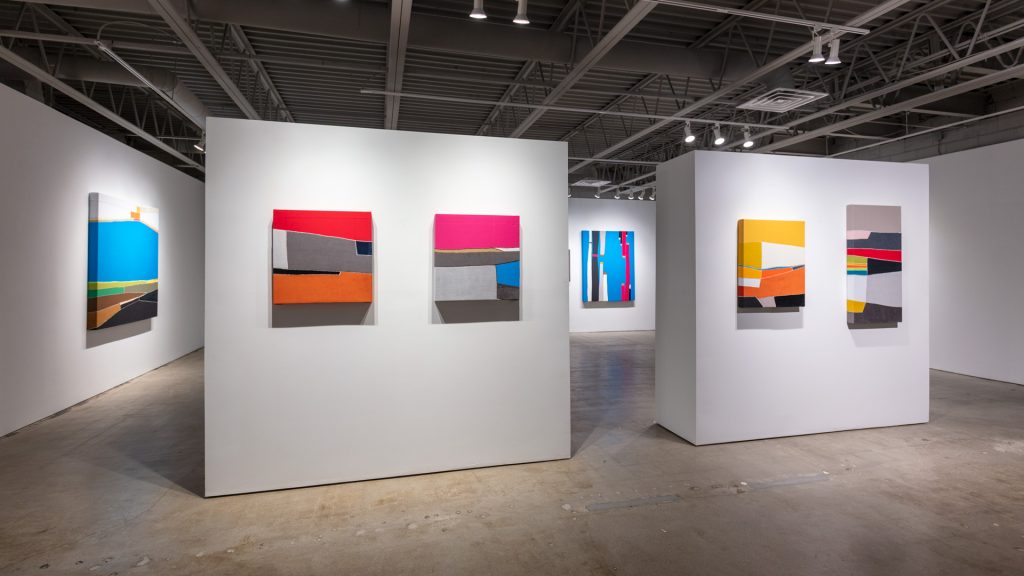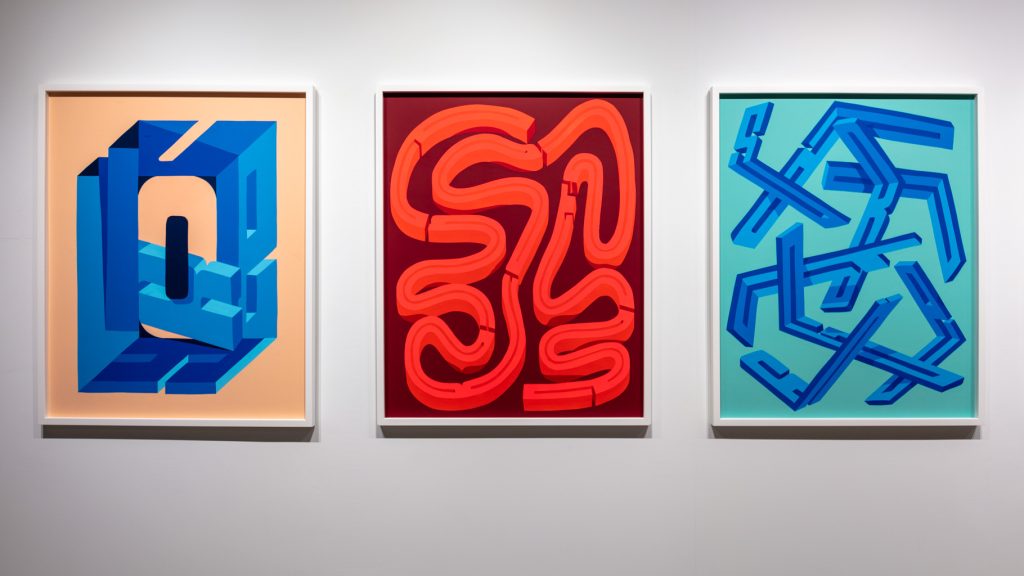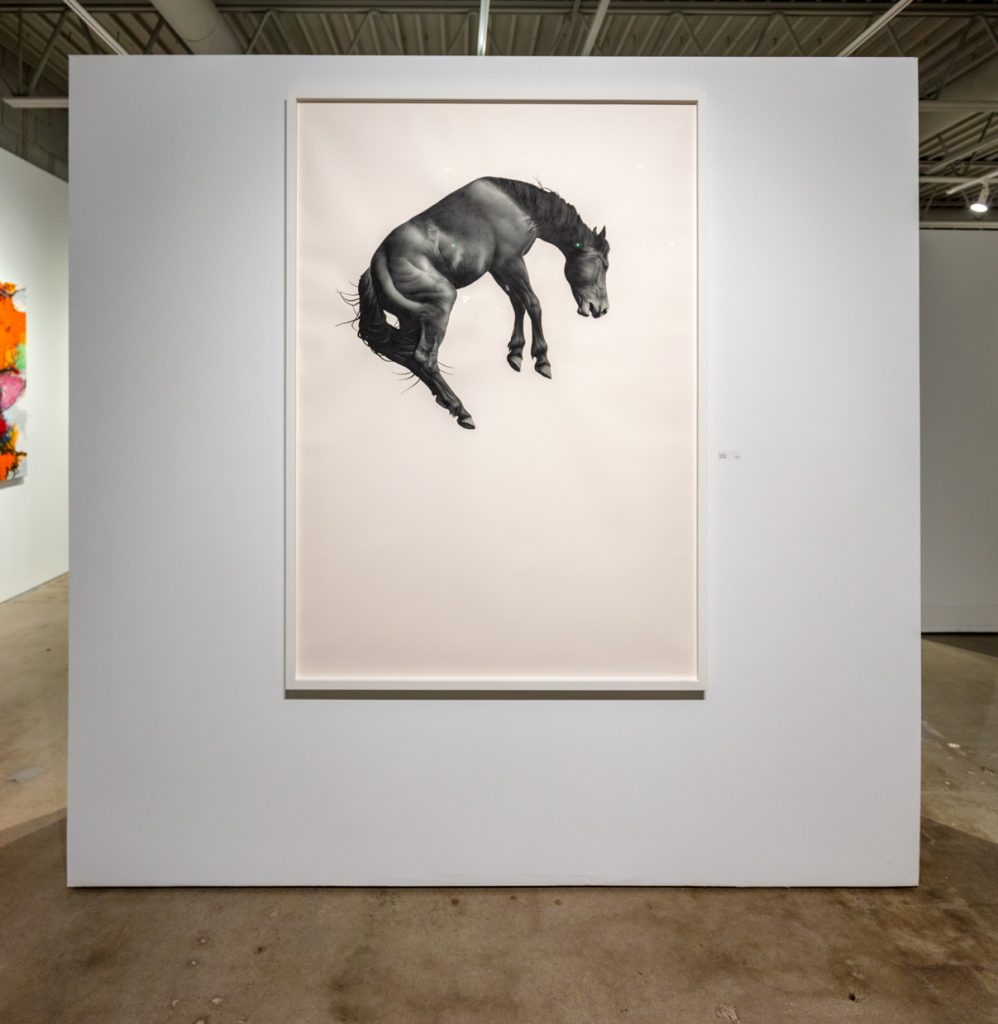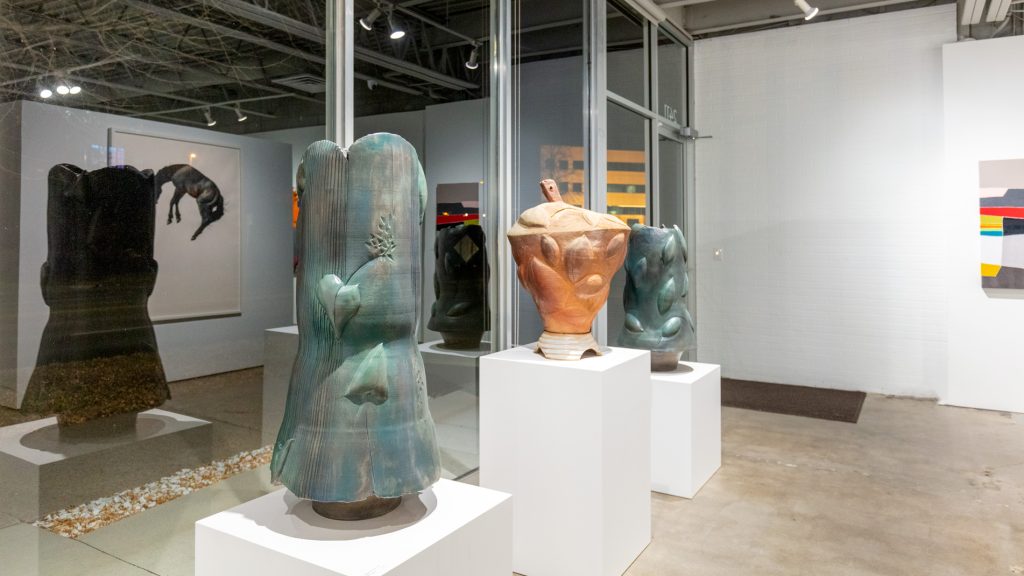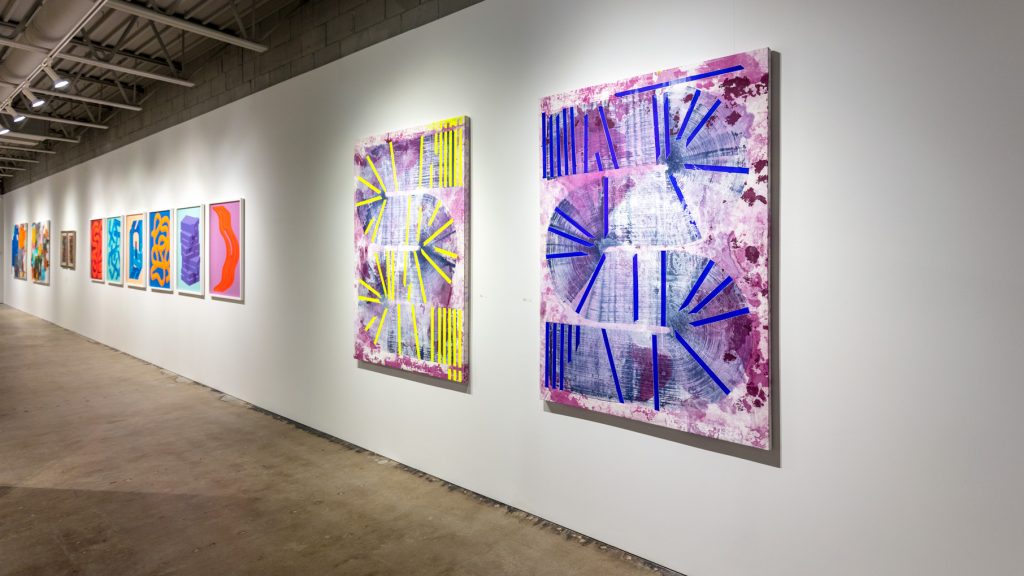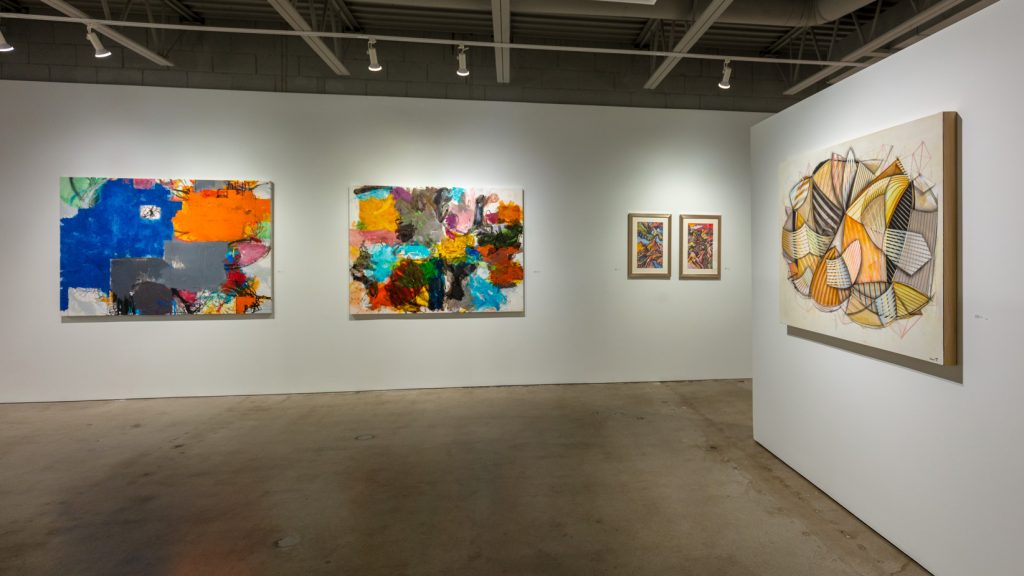TEXT BY MICHAELA MULLIN | VIEW IMAGES
The Moberg Gallery Winter Group Show represents another strange yet fruitful year, 2021, and hopefully helps bring in an even healthier and prosperous one, in 2022. This exhibit is an offering of largesse—artwork in myriad styles, shape, and color, as we feature artist James Ellwanger’s new fabric works, as well as Larassa Kabel’s most recent large-scale horse drawing. We also welcome new artists, Linda Colletta, Leon Hodes, Charoula Nikolaidou, and Jeanette Pasin Sloan. Showing alongside them are fresh pieces from artists more familiar to us: Andrew Clarridge, Sarah Grant, Annck Ibsen, Adele Renault, Pref, Travis Rice, Karen Strohbeen and Bill Luchsinger, and Chris Vance.
James Ellwanger is a multi-media artist, using acrylic, steel, limestone, digital platforms, and is currently focusing on textiles, and their stitching together. Ellwanger creates large and small-scale works, and his use of pattern creates both large and small spatial explosions. These textile “paintings” are subtle conversations between space, color, and material. The nuanced textures exist within the frame are about composition and hue.
Ellwanger’s abstract “land”scapes, stitched in organic and geometric forms, render their stitching to form contours that delineate sharply, giving the eye fields of contrast, and offering a dynamism unexpected in the two-dimensional. The materiality of each of these paintings in fabric draws the viewer in with their hand outstretched. They are testaments to hand/eye coordination, but even more so, the hand/eye collaboration—sheen and suede, perforation and cutouts compel one to feel it. The tactility of the textile compositions, such as in “#355-#357,” operate like different soils and flora, atmosphere, and ranges.
New York-based artist, Leon Hodes, works in various media, creating vibrant paintings which often include elements of collage and text. He cites an eclectic range of sources and influences, including African mythology, nature, medicine, science, street culture, and more. Interested in “the exploration of interconnectedness and order within the apparent randomness of systems,” Hodes works large, using oil, acrylic, and collaged media on canvas to make works that read as stories about fastening together: things, ideas, materials, colors, and people.
Hodes’ art creates a feeling of Crayola-colored delight, as well as an abstractedness that verges on abstracted-mess. These are surprisingly healing to the eyes, which have been trained to find the familiar and recognizable in the world. His paintings allow the floatation of thought and the intermittent serenity that arrives with any type of suspension. Of body, belief, or time. And Place, such as “Domboshawa,” a painting which references caves in Zimbabwe, where Hodes was born—red, grey, and green, with deep blue sky—it is almost a color coding of the land in this village, as the geological strata and dimensions suddenly become one plane, brought together with border and boundary that is discernable but also creates an adjacency that makes neighborly seem as possible as familial.
Linda Colletta got her start in New York City as a scenic artist painting backdrops for MTV and VH1. She mines her personal history to paint layered stories, created through the lenses of “feminism, pop culture, and childhood nostalgia.” Her abstract paintings are born from a “process [that pushes] the limits of materiality.” With texture, stroke, line, and color, Colletta is an emotional investigator. The layering in her work is representative of human/social complexity. Working in many media, including acrylic, graphite, ink, canvas scraps, paint water and skins, she “harvests her studio for recycled remnants.” In using bits from older works in newer ones, the continuity and connectivity of all we do becomes inherent. In these new works, graphic meets imperfection and nuanced chromatic cartography.
The paintings “Blue Interrupted I and II” and “Zombie I and II” take the smooth movement of ink and paint in U-turns and literally interrupt the points at which the shifts occur. Subtle interventions take place in the former, highlighting the space between the turns, in a gesture of allowance. The latter, more disrupted by straight line and color creates a pacing that speeds and slows, slows and speeds. Colletta here uses repetition and directionality to create fluidity or halting, thereby stunningly confusing the question of which is native—the stutter, or the flow, of movement.
Travis Rice’s galactic gems loom large and bright in his large-scale works, which include “Sottsass Tower” and “Memphis Blues.” These evoke the Memphis Group artists of the later 20th century, which included Italian artist, Ettore Sottsass. A movement that was short lived and underappreciated initially, its colors and shapes we identify with the 1980s are now, decades later, appreciated for their mixing of forms and confectionery colors. Rice’s graphic elements in these acrylic paintings on panel take striping and dotting and elevate the cumulative. Like architectural structures which are surfaces for light to create a dynamic document of shadow and shape upon them, Rice reveals the geometric wonders of stacking.
Artist Pref’s new typographic works are more complex and playful, though the message may even be a word or phrase of slight distress (such as “Hold On.”). Winding, labyrinthine letters, in the tradition of concrete poetry, challenge the eye to follow and pause, and then appreciate the whole without scansion. His “En Route” and “Voyeur,” like many of his works, literally enact what the viewer ultimately deciphers in the looking/reading of the painting. The eyes follow elongated letters shaped to maze like paths in the former, reminding us that sight is a key player in our bodies and minds always being ‘en route.’ The latter is a twist and turn with sharp right angles, creating the very window through which the viewer becomes the titular voyeur.
Adele Renault has two new “feather works” in spray paint, like a thumbnail image enlarged so each parting of each feather of each bird (intimated and imagined) becomes a detail we don’t want to miss. “Gutter Paradise 22 & 23” do what they say, illuminating the way light lifts the image, bringing it to the viewer as if it is turned on—this speaks directly to the perception we have of certain species, certain others, who cohabitate the earth but are often overlooked. Renault’s mission is to give flight to that which we often view as and therefore treat as pest-like- not to fly it away but to place it squarely in front of us. She is the painter of the directive, LOOK!
Charoula Nikolaidou’s large-scale paintings are “gestural and instinctive, moving on a purely personal and experiential axis.” In mixed media, are figurative and abstracted scenes. Bodies in repose, bodies standing, bodies sitting–scenes from life are bodies in space. Using patterning, such as dots, X’s, animal print, and more, the repetition that takes place in corners, edges, and backgrounds aims to shimmer the portraits of experiencing, and the “lyrical flow of lines encircles the vibrating bodies in continuous whirlpools.” Her paintings, “Escapism” and “The Calm” create settings for enjoyment and contemplation. A glass of wine, a vase, a window—objects that suggest refinement and beauty. They are like visual punctuation, offering us time to pause, to take a deep breath, before we continue.
Chicago-born artist, Jeanette Pasin Sloan, paints and draws everyday objects, such as kitchen appliances, dishes, and silver wares. Her still lifes are photorealistic and full of reflective surfaces, but they are also investigations of how we live, reflecting the way appliances and containers shape our personal environments.
As a young mother, Pasin Sloan would paint in her kitchen when her children were asleep. Her artwork took a significant turn when she noticed a reflection in a toaster she was painting. Since then, her photorealistic paintings have become filled with patterned drapery beneath silver, melamine, and other reflective surfaces. “Constellation II” and “Diamonds are Forever” are playful studies on the change of, on, and in shape and form, and how a field of dots and lines can become additional stories and dimensions in an otherwise simple cup and spoon.
Larassa Kabel’s new work, “Last Chance,” adds to her Any Minute Now series, otherwise known as ‘the falling horses.’ Kabel began this series after years of owning many horses. She had a vision of “a room hung with giant drawing of horses in free fall that create a space of meditation and disaster.” Kabel understands that strength and vulnerability are directly entwined in this animal—when they fall, they usually break, and there’s not much to be done about it. Humans are weak in comparison, but also don’t contain the inherent vulnerability that comes along with it—not as intensely, that is. But we, as do all living things, carry the inherent ‘disaster’ we call ‘death’ with us from the minute we are born. Kabel’s horses “exist in a blank non-space, because to put them into a landscape would create a narrative in the real world, and they aren’t really that. They are more like a visual poem, representing the internal condition we are all experiencing: a journey of unknown duration […]”
Any day now, the new year will arrive. Please stop in to see Winter Group Show; you will have many chances to see this exhibit up until January 29, 2022. And though we are all free falling in many ways, we at Moberg Gallery hope the view is gorgeous, and that we all cross the threshold of another calendar year in good health and cheer.
Exhibit Images
